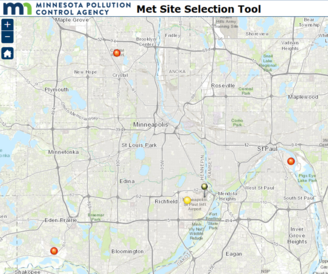
The MPCA recently released a new meteorological site
selection tool (MSST) to help facilities undergoing regulatory air dispersion
modeling select representative weather data. This online tool requires no GIS
experience, and in five minutes or less produces information on meteorological
sites that could otherwise take facilities days of work and an expensive ArcGIS
license to produce. The tool considers
proximity, terrain, and surface characteristics such as surface roughness, snow
cover climatology, and urban/rural considerations to select representative
weather data for a given facility. The technical support document posted with
the tool describes how it considers each parameter in selecting a
meteorological site, as well as additional data regarding wind patterns across
Minnesota. The tool also includes a user’s guide that shows how to run it, and
the various options to retrieve information from the online interface. Even
though the tool objectively selects a meteorological site, it also provides
information on other considered sites that can be used to support alternate
selections. Try the MSST on the MPCA’s
meteorological data webpage. We
encourage users to provide feedback to the air modeling inbox at airmodeling.pca@state.mn.us.
|
The GIS Nearby Source Tool, which helps select potential
nearby sources to include in air modeling demonstrations, has been updated. The
tool now offers emission inventories from 2014-2016 so facilities have the
latest information on actual emissions in their area. The tool, supporting
files, and instructions can be downloaded from the MPCA’s
dispersion modeling tools webpage.
As of
May 1, 2018, all applications for individual air permit administrative
amendments must be completed through the MPCA’s online service (e-Service).
MPCA no longer accepts paper applications for administrative amendments. This spring, the MPCA plans to launch a new
e-Service that will allow facilities to submit applications for individual air
permit reissuance online.
Benefits
Online
submission makes permitting reviews faster by streamlining processes and
decreasing data entry by populating forms with permitting data, thereby
reducing the time required to issue air quality permits.
Getting
started
First-time
users of air quality e-Services should go to the MPCA’s Air permit forms and online
submittals
webpage for help getting started. The forms page has links to all available air
e-Services, instructions on setting up an account and getting facility access,
and a list of information needed for each page in the e-Service. Additional
information will be added for the new service prior to its launch. Once in the
e-Service, users will have access to help files for every page and field. If
the help pages do not have the information you need, contact the MPCA at onlineservices.pca@state.mn.us.
An
e-Services account can be created before the new e-Service goes live. Existing
users can use the same account they already created for individual air
administrative amendment applications to submit individual permit reissuance
applications.
The MPCA is proposing to make changes to the Mercury
Reduction Plan submittal form that is used by facilities to submit their
reduction plans. The purpose of the proposed changes is to clarify information
needed to support an alternative plan based on the requirements of the Mercury
Emission Reduction Plan Rule (Minn. R. 7007.0502, subp.
5(A)(2)). This content is currently addressed by the existing form in
section 5.
The MPCA involved the Mercury TMDL Implementation Oversight
Group and interested stakeholders as part of making these changes. Based on the
input we received, we created a version of the form specific to the ferrous
mining and processing sector, in addition to the generic form. This version of
the form makes the information requested in the plan submittal consistent with
statements made in the mercury reduction rule record related to the Mercury
TMDL Implementation Plan.
The MPCA is requesting additional input on the proposed
revisions from the Mercury TMDL Implementation Oversight Group and interested
stakeholders by May 16, 2018. Please contact Hassan Bouchareb (Hassan.Bouchareb@state.mn.us) for further information and to receive a
copy of the proposed revisions to the Mercury Reduction Plan submittal form.
The existing form can be found on the MPCA’s website.
Be air aware. Know what you’re breathing. Have you wondered about how air quality
affects your health? Find answers on MPCA’s new Air quality and
health webpage, developed with input from the Minnesota Department of
Health. This suite of information is part of MPCA’s continued work to share the
latest information about air quality and health with Minnesotans:
-
Does your child have asthma? Today’s Air
Quality Index may change his or her recommended outdoor activity level. Check
out the outdoor
activity guidance for schools.
-
Did you know your health can be impacted by air
pollution even on “good” air days? Indoor air pollutants can cause health
effects, as well as your proximity to outdoor air pollution sources, such as wood smoke and vehicle
exhaust from major roadways.
-
Are you interested in learning more and
sharing information with your family and friends? Check out the air quality and
health video, Air
quality and you: health effects of air pollution.
-
Interested in taking action? Go to what
you can do about air pollution.


Every
two years, the MPCA estimates and reports to
the Legislature on the volume of pollution emitted or discharged to the state’s
air and water resources. The report details statewide emissions of air pollutants,
including criteria pollutants, greenhouse gases, and air toxics. It also
provides estimates of surface-water discharges from point sources and describes
statewide efforts to reduce neighborhood sources of pollution and monitor and
address contaminants of emerging concern.
Air
pollution trends:
-
Generally, emissions of all major air pollutants are decreasing. Areas of
the state where there may be localized or concentrated emissions from several
sources remain a priority.
-
Permitted sources such as power plants and large factories contribute less
than 25% of statewide emissions due in large part to government regulation,
improved pollution control technology, and switching to cleaner fuels.
- Most air pollution comes from smaller, widespread sources, including
vehicles, small businesses, and construction equipment.
To further explore emissions in
your area, you can use the new interactive air emissions maps on the MPCA’s website.
For more information about the report visit the MPCA
website. Contact Azra Kovacevic (air) or Pat Engelking (water) with any comments or questions.
|

Interested in air quality? Consider promoting Minnesota’s
air quality, or at least a live picture of it!
Now available for your use: A current conditions I-Frame. No coding
experience required. Just copy and paste the code right into your website’s
code where you would like the map. See
the City of Warren and MN Department of
Health who are currently using it on their websites. Visit the MPCA’s AQI embed webpage
to access the code.
|
The MPCA’s Criteria Pollutant Data Explorer now includes
annual summary values for air-monitoring results collected through 2017. This
interactive web tool allows users to map, chart, and download annual data on
monitored criteria pollutant concentrations and compare results to state and
federal air quality standards. To explore the results visit the MPCA’s
website.
Criteria pollutants are those for which the Clean Air Act
requires EPA to set national air quality standards. They include ground-level ozone, particulate
matter, carbon monoxide, lead, nitrogen dioxide, and sulfur dioxide.
The 2017 results show continued improvement in air quality
across Minnesota. Fine-particle (PM2.5) levels continue to fall
dramatically, with improvements from 25 to 45 percent (depending on particle
size) in the annual and daily design values since 2010. All areas of the state
meet federal air quality standards. The MPCA continues to investigate
violations of the state total suspended particulate standards in industrial
areas of North Minneapolis and Duluth. Find more information regarding the
North Minneapolis violations on the
North Minneapolis Air Monitoring Project website. Please contact Cassie
McMahon with any questions (cassie.mcmahon@state.mn.us
or 218-302-6600).
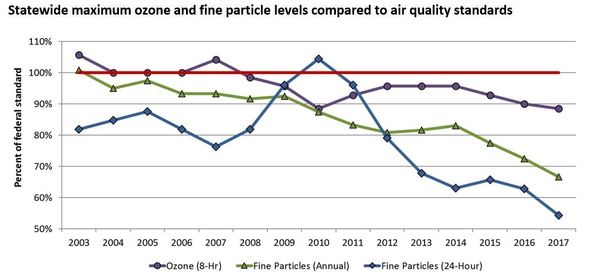

The MPCA, in partnership with Safety-Kleen, is offering a
25-50% discount to small businesses purchasing products to switch from
solvent-based to water-based parts washers.
Small businesses in Minnesota are defined as having 100 or less
employees.
Solvents emit volatile organic compounds (VOCs), which are
air pollutants that contribute to the formation of smog. Switching to water-based parts washers
reduces emissions of these harmful pollutants, which improves air quality for employees
and the community.
To participate, contact your local Safety-Kleen location or
contact Eric David at the MPCA (eric.david@state.mn.us
or 651-757-2218). Visit the MPCA's website for more information.
This pilot project is also being supported by
the city of Minneapolis, which will provide an additional 20% to small
businesses in Minneapolis converting to water-based parts washers.
|
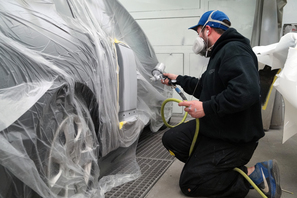
MPCA grants are currently available
for cost-effective projects to reduce emissions of volatile
organic compounds (VOCs) in a wide range of organizations throughout
Minnesota. Many opportunities exist to switch out solvents, inks, coatings,
cleaners, or purchase alternative process equipment or vehicles that both save
money and protect employee and community health.
The first round of grant applications
is due soon -- May 18! However, if you are not ready to apply yet you have
another chance. The second round of applications is due July 20. The
application is easy -- only 2 pages! For more information, visit our VOC
grants webpage.
Eligible applicants: Businesses with under 500 employees (e.g., manufacturers, printers, industrial
finishers, automotive, metal casting, etc.), governmental agencies, educational
institutions, non-profits, trade groups, and associations.
Maximum grant award:
$24,000 with a 50% required match. The most cost-effective projects will score
highest. Special consideration will be given for innovative projects from
targeted applicants in environmental justice and highly urbanized areas.
VOCs are common air pollutants
emitted from everyday chemicals. They contribute
to smog formation and can cause unpleasant health effects like eye and throat
irritation, headaches, and nausea. These effects can be particularly noticeable
in highly urbanized or environmental justice communities.
Refer to the request for proposals
for full details on who may apply for funding, the funding priorities for the 2018
and 2019 grant rounds, match requirements, activities eligible for funding, and
other information that will help applicants submit an application.
|

The draft 2019 Air
Monitoring Network Plan for Minnesota is available for public review and
comment through June 1, 2018. The plan and instructions for submitting comments
are available on the MPCA’s
website.
The purpose of
this annual report is to demonstrate compliance with air monitoring network
regulations, provide an overview of the various air quality monitoring networks
operating in Minnesota, describe proposed changes for the upcoming year, and
share specific information on each of Minnesota's existing and proposed air
quality monitoring sites. For each of the monitoring locations, the network plan
provides details on the location, monitoring objectives, and proposed changes.
The report also provides data for several pollutants to show current conditions
compared to state and federal air quality standards. For more information, or to request hard
copies of the plan or commenting instructions, please contact Christine
Steinwand (651-757-2327 or Christine.Steinwand@state.mn.us).
|

Kevin Dynan began working at the family dry-cleaning
business in the 70s, and using perchloroethylene, or “perc,” to dry-clean
clothes was the only process he had ever known. Today, EPA classifies
perc as a likely carcinogen, and the Occupational Health and Safety
Administration has extensive guidance on working with the chemical. At first, Dynan was not interested in
converting equipment to use a less toxic chemical, but an MPCA grant changed
his mind. Now he feels as though making the switch was one of his best
business decisions. “We ran the first loads in each machine on Thanksgiving
Day, 2017. At that moment, I kicked myself for not making the change 20 years
earlier,” he said. Read more on the MPCA’s
website.
|

The MPCA released its final plan for
investing the first phase of funds the state will receive as part of the
national Volkswagen settlement. The plan
reflects input from over a year of engaging with Minnesotans and hearing their
priorities for the funding. We received
a lot of helpful input on the draft plan and made some changes in
response. Check out our website
for more information on what we heard and how it influenced the final plan.
|
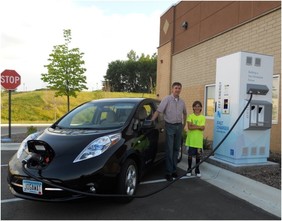 The MPCA plans to seek initial requests for proposals to
replace school buses and install electric vehicle-charging stations in May or
June of 2018. Requests for proposals for the other grant programs outlined in
the state plan will be released over the coming year.
We will post all information on the application process on
our new Diesel
Replacement Program grant opportunities webpage. Sign
up for our emails to keep up with all funding opportunities and please help
spread the word and encourage others to sign up as well! The VW settlement email list will be the best
way to hear when grant applications open.
|
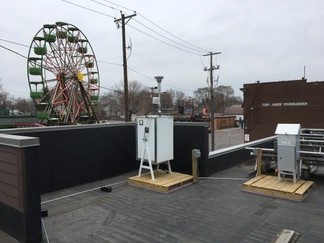
The MPCA’s Community Air Monitoring Project (CAMP)
uses funding from the Minnesota Legislature to do short-term air quality
monitoring in selected Minnesota neighborhoods. The objective is to
monitor and assess air quality in low-income
neighborhoods or communities of color that may be disproportionately impacted
by air pollution from highways, air traffic, or industrial sources.
The CAMP monitor is now located in
the Bottineau/Marshall Terrace neighborhood in Minneapolis. Preliminary
results from this monitor are available on the CAMP
website with an update through the end of
2017 expected to be available in early May.
A short summary of results from the
air monitoring site located at St. Paul Downtown Airport and a detailed summary
of results from the monitor located in
St. Anthony Park in St. Paul in 2016 are now available on the CAMP website. A more detailed
summary of results from the St. Paul Downtown Airport is expected to be
available in early May.
Since starting the project in October
2013, the MPCA has completed monitoring in multiple communities in the Twin
Cities and Duluth. The monitor measures common air pollutants that can be
harmful to breathe, such as fine particles (dust and soot), volatile organic
compounds, and metals. Monitoring from 2013-16 found that generally,
except for a few areas where fine particles were slightly elevated, pollutant
concentrations in the CAMP-monitored neighborhoods were similar to results from
Minnesota’s permanent, statewide air-monitoring network. To learn more about
the monitoring results, visit the website or contact Kari Palmer (kari.palmer@state.mn.us or 651-757-2635). Overall information about the MPCA’s
air monitoring program is available here.
|
In Minnesota, a diverse group of partners works together to
voluntarily reduce air emissions from neighborhood sources. Clean Air Minnesota
convenes stakeholders with representation from state departments,
local government, non-profits, and private companies. The MPCA, with CAM support,
joined EPA’s Advance Program to support
Minnesota’s efforts to achieve voluntary emissions reductions to lower
concentrations of both ozone and fine particles. As researchers better understand the health impacts of air
pollutants, EPA reviews and strengthens national air quality standards, and the
Advance Program helps communities stay ahead of changes.
The MPCA recently submitted its updated annual Advance
report to EPA. This update
shares information on the status of Minnesota’s air quality along with our
state’s accomplishments in addressing emissions from neighborhood sources of
air pollution. The projects that CAM partners
collaborate on help Minnesota achieve measureable emissions reductions and
track our progress.
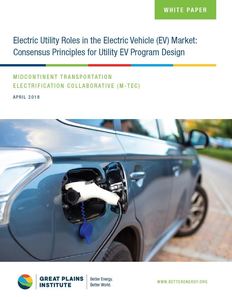 The
MPCA joined a group of regional stakeholders including other states,
automakers, electric utilities, companies that make chargers, and environmental
organizations in developing a white paper on how electric vehicles and grid
transformations can go hand-in-hand to benefit utility customers, the
environment, and the economy. The paper,
titled “Electric
Utility Roles in the Electric Vehicle (EV) Market: Consensus Principles for
Utility EV Program Design,” provides some guiding principles for utility-based EV programs to
benefit consumers besides those who drive EVs, help reduce greenhouse gas
emissions and traditional air pollutants, and benefit energy security and
reliability.
|
The American Lung Association released its annual report on
air quality across the country. You can read
the report and look up air quality information on your state, county, and city on
the ALA website.
On April 13, 2018, EPA formally announced it plans to re-evaluate
the greenhouse gas emissions standards for model year 2022-2025 light-duty
vehicles. Minnesota opposes the rollback
of these standards and has joined other states in suing to block EPA’s
action. Check out this Minnesota
Public Radio story for more.
On April 30, 2018, EPA proposed
a new rule that would require data used for regulations to be publicly
available. The MPCA and others have
expressed concerns that this new rule would limit EPA’s ability to use
epidemiological studies and other protected health data to develop regulations
to protect human health. Check out this Washington Post article for more.
Air Mail is a quarterly,
email-based newsletter featuring updates on air quality issues and the work of
the MPCA and our partners. Subscribers to this list also receive Air Mail
Bulletins, which provide time-sensitive regulatory and technical updates.
To see past issues, Air Mail
Bulletins, or to subscribe, visit the MPCA's website.
If you have questions
or comments about Air Mail, please contact Amanda Jarrett Smith at amanda.smith@state.mn.us.
|